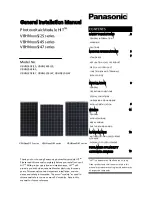
4
3.1Routine Safety
Solglass's module design complies with international IEC 61215 and IEC 61730 standards, and its
application rating is Class A: The module can be used for systems with voltage higher than 50V or
240W DC. And the module has passed IEC 61730-1 and IEC 61730-2, the module meets the
requirements of Class II.
The overall fire rating of the final structure needs to be considered when the module is installed for
use on the roof. At the same time, the overall maintenance is also needed to be considered. Rooftop
PV systems can only be installed after an evaluation by a construction expert or engineer, with formal,
complete structural analysis, and proven to be able to withstand additional system support pressure,
including the pv module's own weight.
For your safety, please do not work on the roof without safety precautions including but not limited to
fall protection, ladders or stairs and personal protective equipment.
For your safety, do not install or handle modules under bad conditions, including but not limited the
high winds or gusts, wet or sandy roofs.
3.2 Electrical Safety
PV products generate direct current in the presence of sunlight, so touching the the wire metal of the
module can be a risk of electric shock or burn. A 30 volt DC or higher voltage can be fatal.
The module also generates voltage without connecting the loads or external circuit. Use an insulated
tool and wear rubber gloves when operating module in the sunlight.
There's no switch on the pv module. The PV module can only be stopped by removing it from the
light or by shielding it with cloth, cardboard, or a completely opaque material, or by placing the front
side of the module on a smooth, flat surface.
In order to avoid the danger of electric arc and electric shock, do not disconnect the electrical
connection under the load. The wrong connection can also cause arcing and electric shocks.
Connectors must be kept dry and clean to ensure that they are in good working condition. Do not
insert a metal object into the connector, or otherwise make an electrical connection.
The power generated by the module may be higher than the nominal rating on the name plate. The
rated output power of the factory test calibration is measured under the module standard test
conditions (module standard test conditions: 1000 W / M2 irradiance, 25 °C ambient temperature,
































